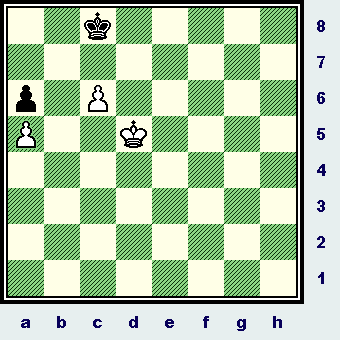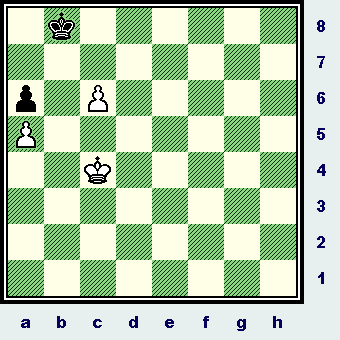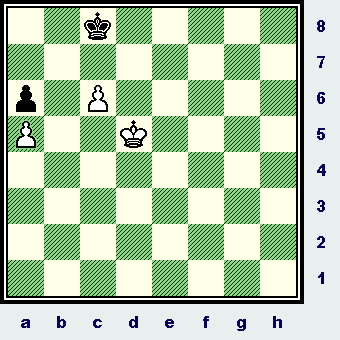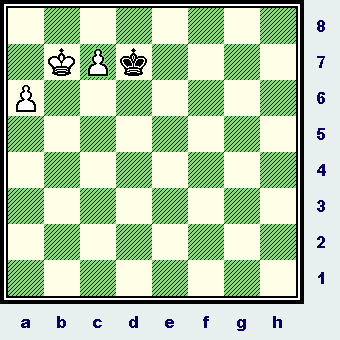All
the |
(Navigation bar
directly below.)
*******
© A.J. Goldsby, 2015.
(All rights reserved.)
****************
Click HERE
to see my
Chess Items.
****************
****************
Buy a book
from Amazon.com
(And help me out as well!)
****************
Click HERE
...
to see a list of the businesses that help to sponsor all of
my chess efforts.
K+P Endgame - Essential Knowledge (#01)
This is an endgame that is absolutely essential to your basic understanding of ALL K+P endings!
Before you go saying, "Oh, that's easy," you should know I have shown this position literally hundreds of times, even masters have had trouble with this one. (The average 1600, who has not really studied chess, generally cannot solve it either.)
This one basic problem ... also features many of the basic ideas of K+P endings. It is a masterful demonstration of the {correct} use of the opposition, and clearly demonstrates how to outflank an opponent in this type of ending. It is also a nascent problem in the theory of corresponding squares as well.
I have dealt with this particular ending many times before. (One example on this page, problem #2.) But as one of my websites - which dealt with mostly K+P endgames - was connected to the "EXCITE" group ... (which folded in 1998 or 1999); I thought it was certainly time for another look at this intriguing King-and-Pawn ending. (I also wanted to check this with the Nalimov Endgame Tablebases, these are very accurate for this type of ending. This tool did not yet exist ... when I first began building web pages on chess. I also wanted to use Fritz 9 as well.)
Click HERE to see an explanation of the symbols that I use when annotating a chess game.
Replay the main line of the solution here.
Endgame problem
|
 |
2k5/8/p1P5/P2K4/8/8/8/8 w
WK - d5, WP's - a5 & c6; BK - c8, BP -
a6.
Checking the "Mega" database, we find that this position has actually occurred in tournament chess a grand total of seven times.
The first
would have to be:
R. Fiebig - S. Tartakower;
Barmen-D / GER; 1905.
{The game was drawn, showing that White did not understand the correct technique that
is necessary to win.}
White to move and win. The first party has a very simple goal here ... to try and re-create this {exact} same situation (position), but with Black to move! (Thus winning the opposition.)
***************************************************************************************************
1.Kc4!!,
The 'book' solution here is Kd4, but the computer shows that this move is also 100%
correct.
White gains ... "The distant opposition."
[ The amateur invariably tries:
</= 1.Kd6?! Kd8; 2.c7+?? Kc8;
3.Kc6, ("=")
when the game is now drawn due to stalemate.
(Black has no legal moves.)
]
1...Kb8!; {See
the diagram below.}
This is probably Black's best, and most confusing defense.
|
|
1k6/8/p1P5/P7/2K5/8/8/8 w
It's a tricky try ... how does White proceed from here?
[ The continuation of:
</=
1...Kc7?;
2.Kc5 Kc8;
3.Kb6 Kb8; 4.Kxa6 Kc7;
5.Kb5, "+/-" {D?}
is an extremely easy win in the K+P endgame for
White.
*******************************************************************************************
The continuation of:
(</=)
1...Kd8!?; 2.Kd4!,
{Diagram?}
is more linear, and allows White to (again) grab the distant {direct}
opposition in this position. [And now
2...Kc8; 3.Kd5, wins for White,
("+/-")
and will transpose to the main line of the solution, (below).]
]
It is White's turn to play in this
position ... what is the first player's best move?
2.Kd4!!,
White could grab "the distant opposition" with 15.Kb4!, but this is better, and actually
shortens the solution by a few moves.
[ The continuation of:
</=
2.Kc5? Kc7; still will win for White,
("+/-")
but prolongs the game for many moves.
(According to the computer.) ]
2...Kc8;
3.Kd5!, {See the
diagram below.}
Mission accomplished, we have reached the same board position, {as before the first
move}; but now it is Black's turn to play, and not White's!!!
(This loss of tempi - using Zugwang - is a common theme in many K+P
endings.)
|
|
2k5/8/p1P5/P2K4/8/8/8/8 b
This is also a good illustration of the concept that "everything is reversed in the ending." (I.e., we spend most of the time trying to GAIN tempo, ... especially during the opening phase. Here - the first player actually did all this maneuvering - in order to LOSE a tempo!!!)
[ 3.Ke4!? ]
The rest does not require a ton of explanation. (White now gains the opposition.)
3...Kc7;
{forced?}
The computer actually shows that this is best.
[ Fritz shows that: </= 3...Kb8?!; 4.Kd6, "+/-" and White wins. (mate in 7) ]
4.Kc5 Kc8;
5.Kb6 Kb8;
6.Kxa6 Kc7; 7.Kb5 Kc8;
8.Kb6 Kd8;
It does not matter here.
[ The continuation of:
"="
8...Kb8; 9.c7+ Kc8;
10.a6 Kd7; 11.Kb7, "+/-"
is similar to the main line. ]
9.c7+ Kc8!?;
10.a6 Kd7; 11.Kb7, "+/-" {See
the diagram below.}
and White will promote a Pawn, the rest is a relatively easy win from here.
|
|
The final position.
White has a decisive advantage, the average player will win from this position.
BIBLIOGRAPHY / REFERENCES:
-
Philidor did a problem similar to this one, as did Bayer.
-
See "Basic Chess Endings," by GM Reuben Fine, and revised by
GM Pal Benko. (Published, 2003) [See page # 22, problem no. 43.] -
"Chess Endgame Training," by Bernd Rosen. (Copyright 2003)
Published by Gambit Books. [Chapter Two, page # 21, problem 2.1] -
I also used Fritz 8 with the Nalimov Tablebases.
Copyright (c) A.J. Goldsby, 2006. All rights reserved.
1 - 0
The analysis for this page was prepared with the excellent program, ChessBase 9.0.
The HTML was polished with several different tools and programs, (mostly FP) ... the text was checked for spelling with MS Word.
The diagrams were created with the program, Chess Captor 2.25.
Copyright (c) LM A.J. Goldsby I
Copyright (©) A.J. Goldsby, 2013. All rights reserved.
This page was created on February 06th, 2006. This page was last edited on: April 19, 2013 09:44 AM .
[Home] [Site Map] [My Training Page] [Endgames, Lessons & Challenges II]


